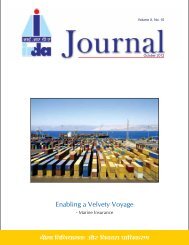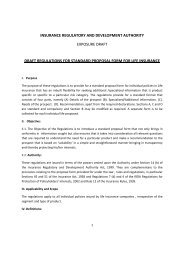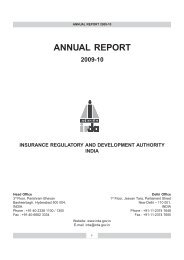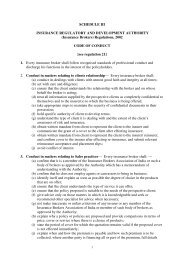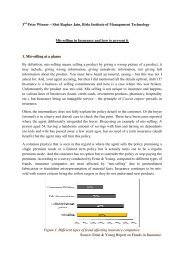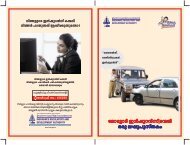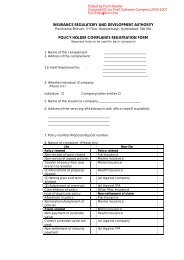Download PDF - IRDA
Download PDF - IRDA
Download PDF - IRDA
You also want an ePaper? Increase the reach of your titles
YUMPU automatically turns print PDFs into web optimized ePapers that Google loves.
ANNUAL REPORT 2011-12<br />
I.4.8.7 In case of a life insurer, the Appointed Actuary<br />
certifi es the company’s technical reserves, solvency<br />
and fairness of premium rates. In addition to this, the<br />
Appointed Actuary must carry out the Economic Capital<br />
calculations in order to ensure proper balance between<br />
capital adequacy and capital efficiency. The Appointed<br />
Actuary has the responsibility to ensure the asset<br />
liability management, so as to enable the insurer to<br />
meet the obligations as and when due, without any<br />
liquidity issues and any sudden shocks with stress<br />
testing.<br />
I.4.8.8 In case of a non-life Insurer, while ensuring the<br />
solvency, the Appointed Actuary is required to certify<br />
the claim provisions relating to IBNR (Incurred But Not<br />
Reported) and IBNER (Incurred But Not Enough<br />
Reported) claims. The Appointed Actuary is also<br />
required to prepare the Financial Condition Report in<br />
order to bring out the challenges which the insurer<br />
carries in terms of meeting solvency requirements,<br />
other parameters which affects the fi nancial condition<br />
of the company, stress testing and asset liability<br />
management. Further, the Appointed Actuary must<br />
carry out the Economic Capital calculations in order to<br />
improve the capital effi ciency.<br />
I.4.8.9 The Appointed Actuary remains responsible to<br />
the Regulatory Authority for providing various<br />
information and certification and he/she is also<br />
empowered to ‘blow the whistle’ when needed. He/she<br />
is also required to conform to the Actuarial Practice<br />
Standards (APS) issued by the Profession from time<br />
to time. In the present scenario, which is driven by<br />
various uncertainties, the Appointed Actuary has a<br />
major role to play to ensure that the interests of various<br />
stakeholders are protected. The procedure for<br />
appointment of an ‘Appointed Actuary’ is stipulated in<br />
<strong>IRDA</strong> (Appointed Actuary) Regulations, 2000. The<br />
Authority is the process of amending these Regulations<br />
by stipulating additional provisions / amending existing<br />
provisions relating to the eligibility criteria.<br />
Actuarial Valuation – Life<br />
I.4.8.10 The analysis of the Actuarial valuation and<br />
related reports was done by the Actuarial Review<br />
Committee (ARC) constituted for the purpose till the<br />
financial year 2009-10. Since the financial year<br />
2010-11, the ARC was dispensed with and the task of<br />
analysis of Actuarial valuation and related reports are<br />
now being carried out internally by the Actuarial<br />
department of the Authority.<br />
Product Approval Committees<br />
I.4.8.11 In order to ensure that the process of insurance<br />
product approval is endowed with necessary expertise<br />
from all the functional areas related to ‘File and Use<br />
procedure’, the Authority has constituted the Product<br />
Approval Committees for approval of products in life<br />
and non-life insurance segments. These Committees<br />
examine the desirability and viability of the products<br />
submitted by the insurers on the bases of actuarial<br />
calculations and actual experience before giving their<br />
approval.<br />
I.4.9 ANTI-MONEY LAUNDERING/COUNTER-<br />
FINANCE OF TERRORISM (AML/CFT) PROGRAMME<br />
FATF Membership - Action Plan<br />
I.4.9.1 The <strong>IRDA</strong> issued the AML/CFT guidelines to the<br />
insurance sector in March 2006 drawing powers from<br />
the Prevention of Money Laundering Act, 2002 and the<br />
Rules framed there under. Since then, the insurance<br />
sector has moved into seventh year of effective AML/<br />
CFT regime in India. Compliance with the requirements<br />
under the guidelines is monitored through off-site /<br />
on-site inspections. The guidelines have been<br />
subjected to thorough evaluation of compliance with<br />
FATF Recommendations. <strong>IRDA</strong> was actively involved<br />
in the assessment processes, which led to India’s<br />
Membership into FATF in June 2010. In the course of<br />
action, India committed to a time bound action plan to<br />
FATF Secretariat comprising of amendments to certain<br />
legislations required under the said Recommendations.<br />
<strong>IRDA</strong> is actively working on action points relevant to<br />
the insurance sector. All the action points have been<br />
accomplished except the one requiring effective<br />
mechanisms on Sharing of Information. <strong>IRDA</strong>’s policy<br />
on sharing of information is already in place. In addition<br />
to the same, being a signatory of Multilateral<br />
Memorandum of Understanding (MMoU) of International<br />
Association of Insurance Supervisors (IAIS), would<br />
provide an international platform for sharing of<br />
information. <strong>IRDA</strong>’s application into MMoU is under<br />
67



